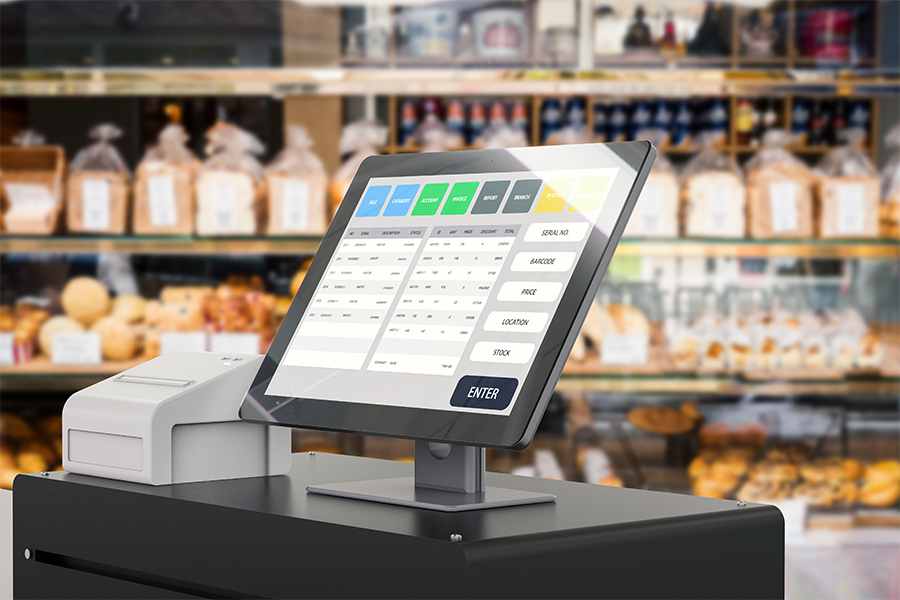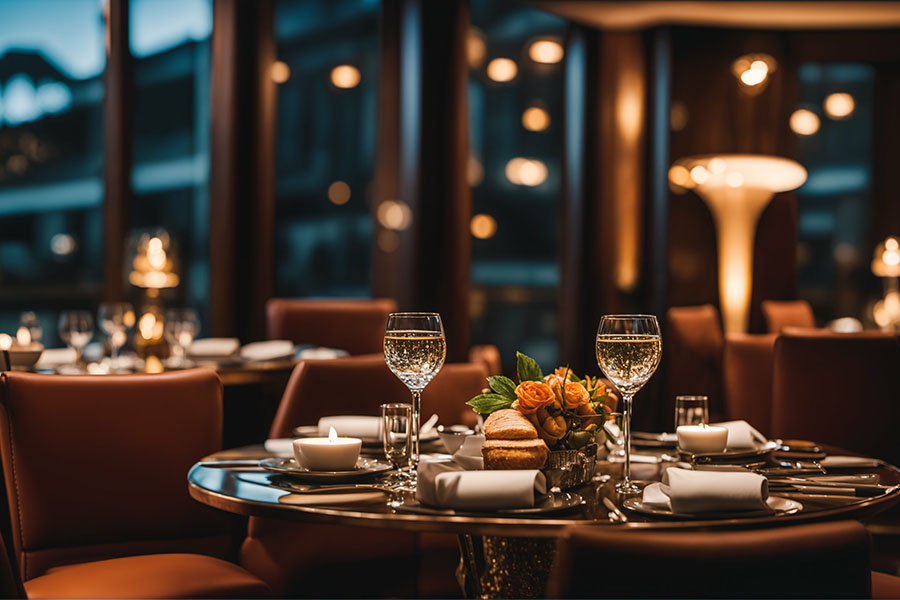
Table turnover is the time it takes to seat a party of guests, serve them, clear the table, and reset the table for the next group of guests. The rate at which you do this will dictate the number of customers you can serve—and the amount of sales you can generate—within your restaurant. The average table turnover rate in the restaurant industry is two to three times a nightly service.
The table turnover rate is one of the most important aspects of managing a dining room and is highly important to your overall success. Below, we discuss table turnover, how to calculate it, and the top ways to improve the rate at which you “turn” a table.
The terms “table turn,” “table turnover rate,” and “turnover rate” are all used often in the food industry. They can be confusing, so it is important to break down exactly what these terms mean:
- Table turn: A table turn refers to when one group of diners leaves, the table is cleaned and reset, and a new party is sat at this table. This metric is important as it is how you continue the flow of business during a service.
- Table turnover rate: Table turnover rate is the rate at which your restaurant clears and resets tables for new guests. Often, chefs or owners will share this with investors or other inquiring parties to portray how efficient the kitchen is at serving and replenishing customers at these tables.
A word about “turnover rate”: Another variation in phrasing you might hear is turnover rate. On its own, turnover rate refers to the quitting and rehiring of staff, and it does not regard customers in the dining room. For more about restaurant employee turnover, see our guide to the Top 10 Ways to Reduce Restaurant Employee Turnover.
When talking about table turns, ensuring the word “table” is used is needed to avoid confusion. You may hear table turns discussed in two ways: in the average amount of time it takes a restaurant to “turn” a table and in the number of “turns” a restaurant averages in a particular service. For example, it is common to hear chefs and restaurant owners say, “With a two-hour service time, we get two and a half turns in a weekend dinner.”
When talking about table turns, ensuring the word “table” is used is needed to avoid confusion. You may hear table turns discussed in two ways: in the average amount of time it takes a restaurant to “turn” a table and in the number of “turns” a restaurant averages in a particular service. For example, it is common to hear chefs and restaurant owners say, “With a two-hour service time, we get two and a half turns in a weekend dinner.”
How to Calculate Table Turnover Rate
The industry average table turnover rate for a traditional restaurant is around 2.5 to 3, depending on the length of the meal being served, service style, and menu type. Most full service restaurants aim for at least two turns in a service. Three turns are excellent and typically a sign of a high-volume restaurant.
To calculate your table turnover rate, you will need some information.
- Day part: The table turnover rate in a restaurant looks at a set period of time, be it lunch, dinner, or brunch service, for example. Actual hours of service vary, so the catch-all industry term for this is “day part.”
- Total number of tables: To calculate the table turnover rate, you will need the number of physical tables in your dining room and
- Total number of tables served: This is the number of tables or parties served during the day part you are analyzing.
With these numbers in hand, this is how to calculate the table turnover rate for a specific day part:
Number of tables served / Number of physical tables = Table turnover rate
Here is an example you may see in a restaurant:
25 tables served / 10 physical tables in the restaurant = 2.5 table turnover rate per service
As you can see, the limit to how many guests you serve in a given service does not simply depend on the number of physical tables you have in a dining room but also on the rate at which you can flip these tables to have them ready for the next set of customers.
Tips to Increase Table Turnover Rate
Increasing the table turnover rate is often the priority of both the restaurant’s general manager (GM) and chef. They typically work in unison to have tables ready to go throughout the night.
The key to turning tables is to give a great experience to each guest that visits while also being efficient and moving the meal along so that the table can be ready to be used for the next set of guests. Below are some of the top tips you can use to increase your table turnover rate so that more customers can dine at your restaurant.
1. Leverage POS Systems
One of the key features of modern point-of-sale (POS) systems is the fact that managing tables is easier than ever before. POS systems will often have built-in features that analyze how fast your tables are being turned and, therefore, can generate the maximum number of tables available for reservations each night. These systems can also lock out tables past a certain point, allowing you to manage the amount of time guests are seated.
Other useful tools from a POS system would include only allowing reservations for the full number of seats at a table, closing and opening sections based on staffing, and time tracking for each section or course the guest is currently on. All of this technology is useful for reducing idle time and improving the table turnover rate in your restaurant.
Toast can track certain points of the meal to keep the experience running smoothly. (Source: Toast)
2. Use Reservation Systems
Reservation systems are lifesavers when you need to increase your table turnover rate. Whether you use paper and pencil or reservation software that integrates with your POS, having a system will reveal opportunities to fit more customers into your dining room. Reservations systems can also manage waitlists and walk-ins, but you get the most use out of them if your restaurant actually operates by accepting reservations in advance.
Tock’s Timeline view is an excellent way to build turns when taking reservations. (Source: Tock)
Most modern reservation software includes grid or timeline views that show each table throughout your hours of operation. So, you can slot reservations into specific tables and build turns before you ever open your doors for the day. You can do something similar with a spreadsheet or pencil and paper.
Anything can happen during a service, of course. The specific tables turning will likely change as tables dine at different paces, but if you’ve built the turns in advance, you can be pretty confident that some tables will reset in time for the next reservations.
3. Have a Cancellation Policy
This is related to the previous tip. If you accept reservations, you need a cancellation and no-show policy. Cancellations and no-shows will derail any plans you have to build efficient table turns. Some restaurants take deposits for each reservation or require a credit card to book. These restaurants typically charge a no-show fee if the customer cancels less than 24 hours in advance or fails to show up for their reservation.
Your policy might not involve charging customers, though. Admittedly, keeping track of all those credit card numbers might be a riskier and administrative burden than you care for. Even a simple policy like advising reserved and waitlisted guests that you will only hold their table for 15 minutes, after which they forfeit their reservation (or place on the waitlist) is usually enough to keep your tables turning.
Whatever your cancellation or no-show policy is, the steps are the same:
- Establish your policy.
- Post your policy at your front desk or entryway—somewhere customers cannot miss it.
- Communicate the policy verbally to customers when they make reservations or add themselves to your waitlist.
4. Set Up Your Dining Room Efficiently
How you set up your dining room can largely impact your table turnover rate and the overall guest experience. For starters, if the dining room is cluttered and not set up effectively for your staff to work in, then it will take longer to serve guests and get their meals finished. This poor setup can also lead to confusion, misplaced meals, and a general lack of efficiency, which will cost you money in the long run.
Additionally, your tables should make sense for your customers. For example, if your restaurant often serves couples or groups of four, having four- and two-seater tables is ideal as it gives you more space for more customers to dine in. But if you host families or larger parties, having larger tables is key to accommodating them. Knowing the number of guests that you will be serving at each table lets you optimize the setup to increase your table turnover rate.
Floor maps such as this can help you design your dining room for better overall efficiency. (Source: Eat App)
5. Set Standard Times for Each Table
One important aspect of turning tables you can implement in your restaurant is setting designated times that diners have at each table. For a traditional restaurant, 1.5 to 2 hours is the typical allotted time. This way, the expectation is set that the meal must be done within this time frame.
You can display this guideline when guests make reservations or confirm with them verbally over the phone that this is your policy. While it can be intimidating to implement this policy at first, being firm with the length of time your customers have at your tables is integral to maximizing your table turnover rate.
It’s easier to ask customers to vacate a table at the end of their meal if you have somewhere for them to go. If you have a bar area, that’s a great go-to. If you don’t have a bar, set up a few chairs and cocktail tables in an entryway or patio for customers where you can offer complimentary after-dinner coffees or cocktails.
Staff Writer – Retail and Restaurants at FitSmallBusiness
6. Train Your Staff for Efficiency
Training your staff to be efficient when working with customers and preparing food for diners pays dividends when it comes to a better table turnover rate. A well-trained staff allows the service of food to go by faster. Guests are seated quicker, orders are taken promptly, and food is delivered on time. This flow of service keeps the course of a meal on pace and allows for an acceptable table turn time.
Regarding the kitchen, this means a staff that is set up to receive orders from the dining room and execute them in a timely manner. Staff that are well-prepared for busy services understand the timing between courses while preparing high-quality, consistent food. A well-trained back of house leads to shorter wait times and faster table turns.
Front-of-house training includes accurate order-taking and attentiveness in moving the meals along for your guests. Being sure to check in with diners when they sit down, looking for cues to offer service, and finishing a meal with a prompt check drop are all ways to ensure efficiency in your dining room. Your table turnover rate relies on the ability of your waitstaff to move a meal along, so setting goals and training them to hit these goals is key to a better overall table turnover rate.
Planning out preshift is key to successful table turns. (Source: WebstaurantStore)
7. Use Prix Fixe Meals When Possible
A great tool for improving your restaurant’s table turnover rate is using prix fixe or set menus when possible. Prix fixe menus provide a structured meal setting that can be tailored to your dining room needs and the optimal length of time a meal should run within your business. Prix fixe meals allow your staff to prep more accordingly, enable your front-of-house team to plan seating arrangements more effectively, and provide a structure that can then be used to increase your table turnover rate.
Prix fixe meals can be used to set the tone and dictate the best meals you are providing to your customers. (Source: Tango Cafe)
8. Add Payment Options
A part of the dining experience that can take more time than needed is the payment portion of a meal. Waiting for the check and returning the check to run the payment take time and will lead to guests staying at their tables longer. Adopting contactless payments, payments done through handheld devices, or payments finalized through a QR code are all popular ways to reduce the payment waiting times for guests.
While it may be a small portion of the meal, waiting for a check across all of your tables can add up, especially when you are short on staff. Providing quick ways to execute payments is a great way to reduce table turn times in restaurants.
QR codes such as this can reduce wait times and ordering times in dining room settings. (Source: Presto)
9. Avoid Sitting Incomplete Parties
If your restaurant has a strict time limit to adhere to reservations, then you should refrain from seating incomplete parties when possible. While you want to create a meaningful restaurant experience, you also have the responsibility of a business.
Letting a table get bogged down by late guests is detrimental to service prep, your bottom line, and the success of your overall business. By adhering to time constraints on reservations, especially during busy evenings, and by not seating incomplete parties, you can use space that would have been used waiting for customers to show up.
10. Look at Your Operating Hours
Assessing when your business is open and understanding how this affects the broader success of table turn times is very important. I have seen many restaurants have their lunch service bleed into dinner service, causing missed customer opportunities and a lack of being ready for the busier night’s service.
Ensuring your operating hours set your team up for success and your guests up for a great meal is crucial. This could mean ending lunch an hour early to have time to be ready for dinner. Or, it could mean extending your operating hours on busier nights to fit in an extra turn on your tables. Assessing your hours of operation is key to ensuring you are set up for better table turns throughout the night.
Frequently Asked Questions (FAQs)
These are some of the most common questions I encounter about restaurant turnover rates. Click through the sections to learn more.
Table turnover rate is important to a restaurant as it is a metric by which you can gauge how effectively you are using your space. With thin margins in the restaurant industry, being able to turn tables to serve more guests helps push revenue and subsequent profit. You are looking to gain profit and revenue in the same allotted amount of time each night, and having a good table turnover rate allows you to accomplish this goal.
The average table turnover rate for a standard restaurant is two to three times a night. This means the same table will seat two to three different dining parties per service. This changes by concept, where a fast food restaurant like McDonald’s will be much higher due to the speed of the service and concept. If you are averaging two to three turns per table per night in a restaurant, you are operating at an average industry rate.
A couple of key factors can lead to poor table turnover rates in restaurants. First, inaccurate food preparation and order-taking can put tables behind. Poor dining room layout and customer seating can also add to slower overall service. A lack of reservation and seat assignment organization can lead to slower table turns. Finally, a lack of efficiency and speed to move the diner along through their meal can bog your dining room down.
Bottom Line
When it comes to reducing turn times in a restaurant, increasing your table turnover rate is key. By having efficient processes in reservations, guest seating, and guest meal progression, you can use your dining room to its fullest capacity. A focus on a quality meal is aligned with better table turnover rates, as you will have the option to serve more guests in a more refined way. Use the tips above to reduce table wait times and maximize the dining room in which you are serving your customers.


![how-to-handle-restaurant-customer-complaints-[+scripts]](https://zabollah.com/wp-content/uploads/2024/04/13721-how-to-handle-restaurant-customer-complaints-scripts.jpg)
